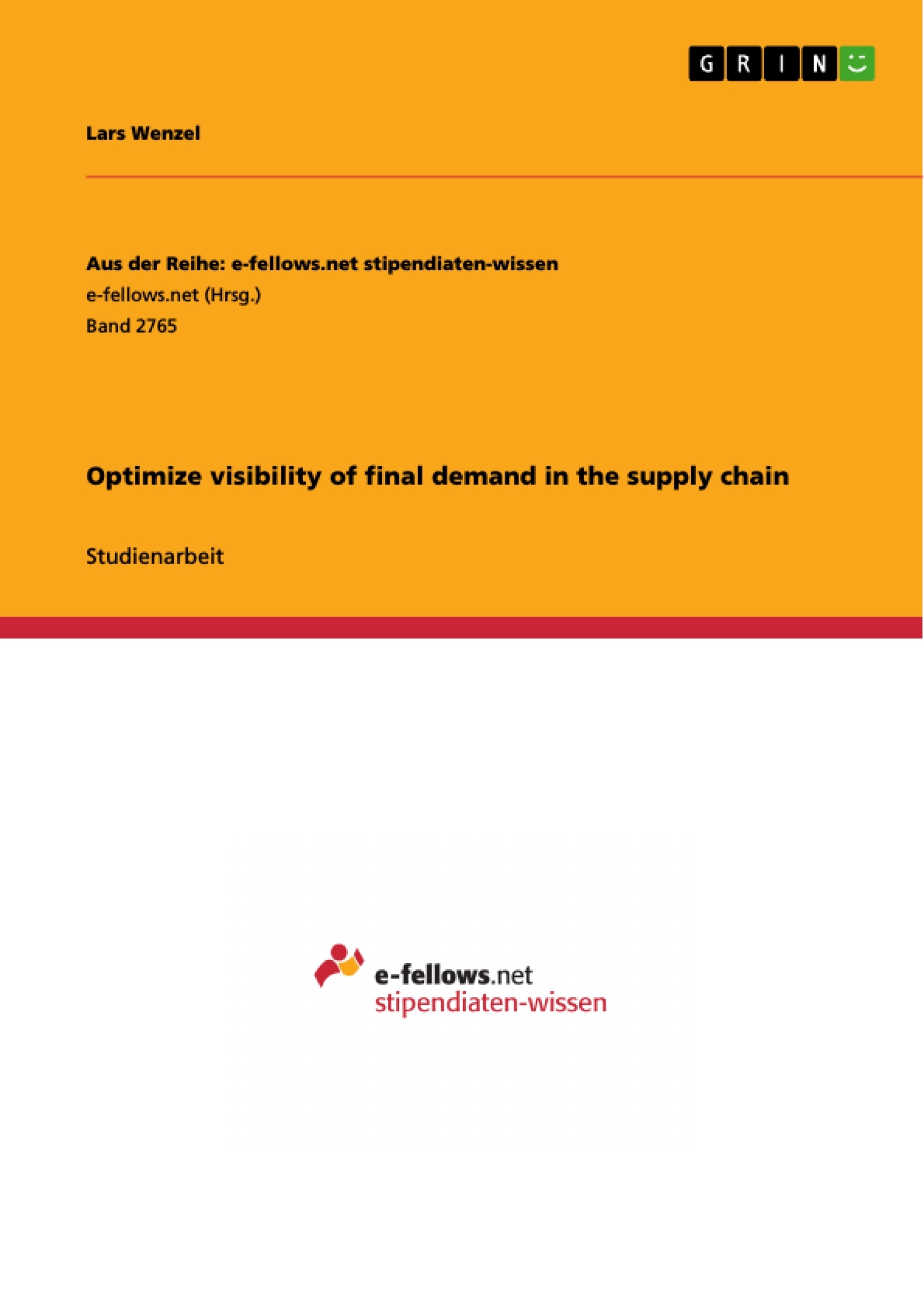The problem in the simulation game "Supply Chain Simulation Module" was that the different players of a chain (supplier, manufacturer, retailer / wholesaler (customer)) communicated exclusively with orders in order to fulfill the given market demand or the needs of their teammates. Due to delays in deliveries, there were increased orders in period three, which already exceeded the final demand as a whole. This led to a chaotic ordering and / or demand behavior. The uncertainties in the demand forecast initially led to bottlenecks. The bottlenecks led to higher safety stocks, which led to overproduction. This led to a negatively evolving supply chain that affected the company. This phenomenon is also referred to as a bullwhip effect.
In this assignment, a possible cause, which has strengthened the bullwhip effect, is investigated. The role of the author in order management as well as the presentation topic "Information and Funds Flow in Supply Chains" are taken into account. During the execution of the planning game, the author was free to choose within the order management whether he should initiate an internal production or serve the customer demand from the warehouse. This free decision leaves a very high risk of the bullwhip effect taking place. Decisions are made without knowing all possible outcomes which can have a reverberating effect on the entire company. For this reason the assignment is being investigated. It is researched which tools are necessary for the order management to make secure and reliable decisions in the future. In addition, it will be shown how the communication within the company can be improved.
Inhaltsverzeichnis
- 1 Introduction: the bullwhip problem
- 2 Supply Chain Management (SCM)
- 2.1 The value-adding process across companies
- 2.2 The first law of the Supply Chain Dynamic
- 2.3 Supply Chain Planning (SCP)
- 3 Demand Planning
- 3.1 Demand Fulfillment (DF)
- 3.2 Available to Promise (ATP)
- 3.2.1 Responsibilities of Demand Fulfillment
- 3.2.2 Order Promising
- 3.2.3 Master Planning as the common basis
- 3.2.4 Assembly-to-Order
- 3.2.5 Bottleneck Planning
- 3.2.6 Demand Supply Matching (DSM)
- 4 Practical example
- 4.1 Introduction
- 4.2 Starting situation
- 4.3 Available-to-Promise in the case Assembly-to-Order
- 4.4 Possible improvements
- 5 Conclusion
Zielsetzung und Themenschwerpunkte
Die vorliegende Arbeit untersucht die Ursachen und Folgen des Bullwhip-Effekts in der Supply Chain und analysiert die Möglichkeiten, die Sichtbarkeit der Endkundennachfrage in der Supply Chain zu optimieren. Ziel ist es, die Entscheidungsfindung im Ordermanagement zu verbessern und die Kommunikation innerhalb der Supply Chain zu optimieren.
- Bullwhip-Effekt und dessen Ursachen
- Optimierung der Sichtbarkeit der Endkundennachfrage
- Verbesserung der Entscheidungsfindung im Ordermanagement
- Kommunikation innerhalb der Supply Chain
- Anwendung von Tools und Methoden zur Verbesserung der Supply Chain
Zusammenfassung der Kapitel
- Kapitel 1: Introduction: the bullwhip problem: Dieses Kapitel führt in die Problematik des Bullwhip-Effekts ein, der durch verzögerte Lieferungen und Unsicherheiten in der Nachfrageprognose entsteht. Es wird gezeigt, wie sich dieser Effekt auf die gesamte Supply Chain auswirken kann.
- Kapitel 2: Supply Chain Management (SCM): Dieses Kapitel befasst sich mit den grundlegenden Prinzipien des Supply Chain Managements, einschließlich der Wertkette, der Supply Chain Dynamics und der Supply Chain Planning. Es wird ein Überblick über die verschiedenen Prozesse und Aufgaben im Supply Chain Management gegeben.
- Kapitel 3: Demand Planning: In diesem Kapitel werden die verschiedenen Methoden zur Bedarfsplanung, einschließlich der Demand Fulfillment, Available-to-Promise und des Master Planning, vorgestellt. Es wird erläutert, wie diese Methoden zur Optimierung der Sichtbarkeit der Endkundennachfrage beitragen können.
- Kapitel 4: Practical example: Dieses Kapitel präsentiert ein praktisches Beispiel aus der Praxis, in dem die Anwendung der im Kapitel 3 vorgestellten Methoden zur Verbesserung der Entscheidungsfindung im Ordermanagement und zur Steigerung der Supply Chain-Effizienz gezeigt wird.
Schlüsselwörter
Die wichtigsten Schlüsselwörter dieser Arbeit sind: Supply Chain Management, Bullwhip-Effekt, Sichtbarkeit der Endkundennachfrage, Ordermanagement, Demand Planning, Available-to-Promise, Master Planning, Assembly-to-Order, Bottleneck Planning, Demand Supply Matching, Kommunikation, Entscheidungsfindung, Supply Chain Optimierung.
- Quote paper
- Lars Wenzel (Author), 2017, Optimize visibility of final demand in the supply chain, Munich, GRIN Verlag, https://www.grin.com/document/428231




